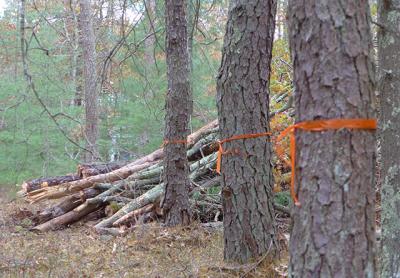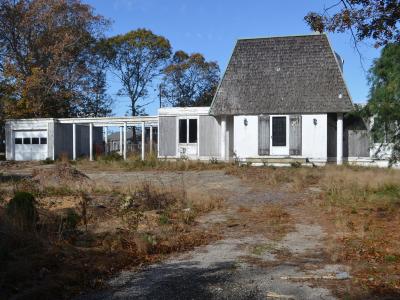Surprise Cost as Beetle Ravages Pines
Surprise Cost as Beetle Ravages Pines

Property owners in Northwest Woods who have already suffered the loss of hundreds of pine trees to a beetle infestation are learning that they will have to bear the cost of removing the trunks and debris after crews hired by the town cut them down.
David Cataletto of Swamp Road in East Hampton is one such resident. After giving town officials permission to identify affected trees and cut them down, he was left with approximately 100 trunks in tall stacks and told he would have to remove them at his own expense.
At a house nearby owned by Gregory Press, 179 trees have already been cut, with others still standing with orange tape indicating that they will have to go. Like Mr. Cataletto, Mr. Press said that he wondered who should pay for removal of what the work crews leave behind.
Just up the road, Susan Metzger looks out of her kitchen window onto her own mountain of logs, 80-foot-tall trees now piled up like matchsticks. “I am overwhelmed and kind of sad. I have no recourse. I don’t know where to turn,” she said.
The rice-grain-size creature responsible for starting all this devastation is the southern pine beetle, whose spread northward is thought to have been caused by climate change. As winters have gotten milder in recent decades, the tiny scourge has moved north, extending its range from Florida to New York.
In East Hampton, so far, the damage has been mostly confined to pitch pines, a rough-barked tree that can grow to about 100 feet. However, in highly infested areas other pines, as well as hemlocks and spruce, can be attacked as well.
They do their damage by feeding on the growing area just beneath the bark, leaving reddish serpentine patterns reminiscent of a henna design that can be seen if the bark is pulled away. Trained eyes can easily spot infested trees from the popcorn-shaped clumps of resin that emerge or “shotgun-blast” patterned holes in the bark.
In addition to East Hampton’s Northwest Woods, the beetles have been found in the Long Island Pine Barrens, the Wertheim National Wildlife Refuge in Shirley, Connetquot River State Park in Islip, and Hubbard County Park in Hampton Bays.
In October, East Hampton Town officials began sending letters to property owners seeking access in areas where pine beetles were suspected. Town Supervisor Larry Cantwell declared a state of emergency on Oct. 26 once it became clear that as many as 2,000 trees were already affected. The declaration allowed contractors hired by the town to work on private property, but not to remove or chip the trees at the town’s expense once they were down.
Scott Wilson, the town’s director of land management, said it has been a fast-growing challenge. Mr. Wilson said that at the end of October about 800 trees on just over six acres of public and private woodland were thought to be infected. By this week the figure had grown to 4,500 trees and counting. The strategy is to topple the trees, cut off their crowns, and score the bark so that the beetles are exposed to predators and the cold in an attempt to halt their spread.
Town Councilman Peter Van Scoyoc’s own Northwest Woods house lot has infested trees on it, as does Councilman-elect Jeff Bragman’s. Mr. Van Scoyoc will take over as supervisor from Mr. Cantwell in January; he excused himself from a discussion of the beetles during a board meeting in Montauk on Tuesday, although he said his property had been devastated and that there was almost nothing left standing.
“The problem is taking the pieces away,” John Cataletto, speaking on behalf of his son, David Cataletto, said at the Tuesday meeting. “What if a homeowner does not have the wherewithal; I am not sure what he does.”
“The homeowner is saddled with a financial burden of getting rid of these logs and taking them to the dump,” he said.
Michael Sendlenski, the East Hampton Town attorney, said that the town was blocked by state law from helping property owners with the cost of disposing of the trees.
“It would not be legal for the town to remove them beyond the point of knocking down and felling trees. Removing or chipping the trees goes beyond the state of emergency. The town’s hands are tied,” Mr. Sendlenski said. “They would be dead anyway, standing, and would have to come down anyway,” he said.
Mr. Press said in an interview that a worker who had been on his property had approached him about taking his logs away but that he had been vague about the cost. Mr. Cataletto said that his son had yet to seek estimates.
Mr. Wilson said Tuesday that there had been some difficulty getting the agreement letters signed by homeowners, speculating that many may be away at this time of year. The town initially set aside $80,000 for tree cutting. More money, perhaps from the state, is expected soon, Mr. Wilson said.
“It is a suppression effort, not eradiction,” Mr. Wilson said. He urged landowners, especially in Northwest Woods, to phone his office if the suspect beetles might be on their properties. “There is a distinct possibility that we could lose all the pitch pine trees in Northwest,” he said.
The East Hampton Town Board is contemplating waiving fees at the town recycling center on Springs-Fireplace Road for property owners who drop off trees from the affected area. It may take up the question at a meeting tonight at Town Hall.
“I am in mourning. You have no idea,” Ms. Metzger, who has lived in Northwest since 2004, said. She said that her daughter had told her to look on the bright side and consider all the light that now reached her property.
“I didn't want more light. If I had wanted more light, I wouldn't have bought here,” she said.







